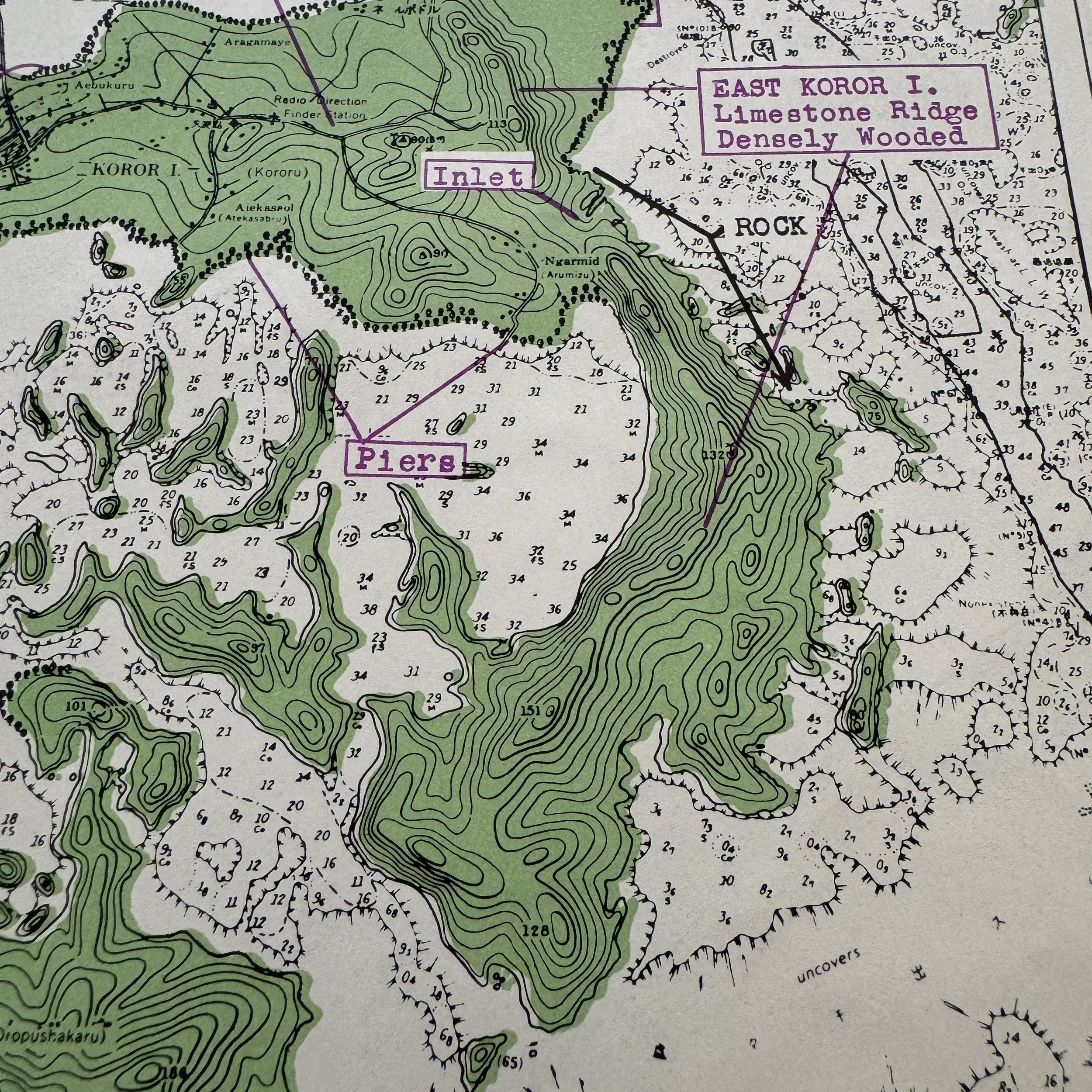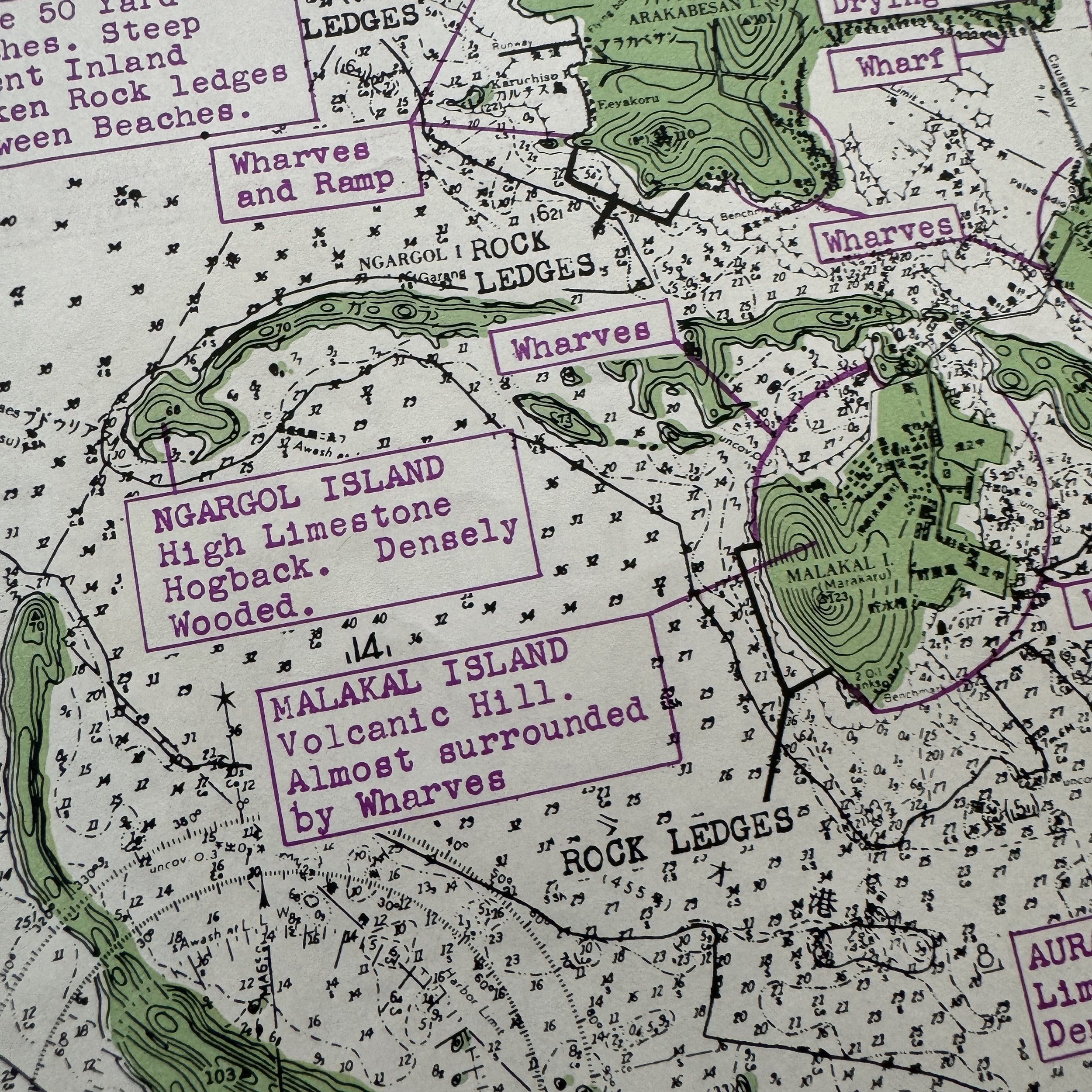VERY RARE! WWII 1944 Operation Stalemate II - Palau Campaign (Koror Island) CONFIDENTIAL Combat Intelligence Invasion Maps (Double-Sided)




































VERY RARE! WWII 1944 Operation Stalemate II - Palau Campaign (Koror Island) CONFIDENTIAL Combat Intelligence Invasion Maps (Double-Sided)
Comes with a hand-signed C.O.A.
Size: 13 x 14 inches
This incredibly rare and museum-grade WWII artifact is an original World War II Operation Stalemate II CONFIDENTIAL marked combat intelligence invasion maps (double-sided).
As per military classification guidelines at the time, it states, “It is recommended that "Top Secret" material - Operation Plans and Orders - be reclassified downward to "Secret or Confidential" prior to the start of an operation by a sufficient length of time to permit of adequate and timely distribution to commanders and officers and concerned. Only when in that area of combat theater can maps, reports, and plans be re-classified as “Restricted” to be used in combat and in the field.”
Dated June 1944 (3 months prior to the D-Day invasion of the Palua Islands) this map was a part of the largest amphibious operation in the Pacific to date, with more than 1,600 ships and craft and more than 800 aircraft deployed.
The Joint Intelligence Center Pacific Ocean Areas (JICPOA) played a pivotal role in producing military intelligence during World War II, particularly in the Pacific Theater. Established in 1943 under the command of Admiral Chester Nimitz, JICPOA was tasked with gathering, analyzing, and disseminating intelligence across the vast Pacific Ocean Area, covering millions of square miles of ocean and land. JICPOA’s multi-branch organization combined resources from the U.S. Army, Navy, Marine Corps, and other intelligence units, making it a hub for coordinated intelligence operations during the war.
One of JICPOA’s most significant contributions during WWII was in the preparation for amphibious assaults, such as the Battle of Peleliu in the Palau Islands, part of the larger Operation Stalemate II in 1944. JICPOA was responsible for producing detailed intelligence maps that were critical for the U.S. military's planning and execution of the invasion. These maps were created from aerial reconnaissance, submarine patrols, and photo interpretation, and they provided precise topographical details, enemy troop positions, and the layout of defensive installations, including the extensive cave networks that Japanese forces used for fortification.
For the Battle of Peleliu, JICPOA’s intelligence maps informed U.S. commanders about the island’s challenging terrain, fortifications, radio systems and more giving the U.S. forces a clearer understanding of what to expect. However, despite these detailed maps and military intelligence, the battle proved more difficult than anticipated due to the Japanese strategy of using fortified positions rather than a direct beach defense, leading to a protracted and costly engagement.
JICPOA’s ability to produce accurate intelligence maps underlined the importance of coordinated intelligence in modern warfare. The maps not only provided essential strategic insights but also saved lives by enabling U.S. forces to better prepare for the enemy’s defenses. In the Battle of Peleliu and other Pacific campaigns, JICPOA’s intelligence gathering and map production were critical in shaping the success of U.S. operations, contributing to the eventual Allied victory in the Pacific.
The Invasion of the Palau Islands and the Battle of Koror Island: A Critical Pacific Theater Campaign
The invasion of the Palau Islands in World War II, particularly the battle for Koror Island, represents one of the most significant and intense engagements of the Pacific Theater. Situated in the western Pacific Ocean, the Palau Islands are part of the larger Caroline Islands chain, located strategically between the Philippines and Guam. During World War II, these islands held immense importance due to their proximity to major Japanese defensive positions and potential as staging areas for Allied forces in their push towards Japan. The Battle of Koror Island, though often overshadowed by larger operations such as Iwo Jima or Okinawa, was a critical component of the Allied strategy to neutralize Japanese strongholds in the Pacific.
Strategic Importance of the Palau Islands
The Palau Islands, composed of over 300 islands, were of crucial strategic value to both Japanese and Allied forces during World War II. For the Japanese, the islands were a key defensive perimeter in their Pacific stronghold. Control of the Palau Islands allowed Japan to safeguard vital sea routes and maintain lines of communication and supply between its territories in the Philippines, Southeast Asia, and the Pacific. Moreover, the Palau Islands housed important airfields that could be used to launch attacks on advancing Allied forces.
For the Allies, capturing the Palau Islands, particularly Koror Island, would serve two critical purposes: first, it would help isolate Japanese forces in the Philippines and cut off reinforcements and supplies to those regions; second, the islands could be used as forward bases for future operations, particularly for the planned invasion of the Philippines, which would bring Allied forces closer to Japan's home islands.
The Palau campaign was part of the broader Allied "island-hopping" strategy, which aimed to bypass heavily fortified Japanese positions by capturing strategically significant islands while leaving others isolated and without support. This strategy had been used successfully in the capture of the Marshall Islands and the Marianas and would now be applied to the Palau Islands.
The Invasion of the Palau Islands
In September 1944, the United States launched Operation Stalemate II, the invasion of the Palau Islands. The operation was led by Admiral Chester W. Nimitz and focused on two main objectives: the capture of Peleliu and the neutralization of Koror Island, which was the administrative center and logistical hub of the Japanese garrison in the Palau archipelago.
Peleliu, the site of a major airfield, was deemed the most important objective due to its potential use in future operations in the Philippines. However, the capture of Koror Island was also essential, as it housed Japanese headquarters and important infrastructure supporting Japanese operations in the region.
While the primary focus of the U.S. assault was on Peleliu, with the 1st Marine Division tasked with its capture, the invasion of the surrounding islands, including Koror, was carried out by the U.S. Army's 81st Infantry Division. The strategy was to neutralize Koror Island and surrounding islands through a combination of aerial bombardment, naval artillery, and amphibious landings.
The Battle of Koror Island
Koror Island, the administrative and military center of the Palau Islands, was heavily fortified by Japanese forces. The island's defenses were manned by approximately 10,000 Japanese troops under the command of Colonel Kunio Nakagawa, a seasoned officer who had experience in defensive operations. The island's rugged terrain, combined with the construction of fortified bunkers, caves, and underground tunnels, made Koror a formidable stronghold.
The battle for Koror Island was characterized by intense and prolonged fighting. Prior to the landing of U.S. forces, Koror was subjected to a relentless aerial and naval bombardment. U.S. planes from aircraft carriers pounded Japanese positions, while battleships and cruisers shelled the island from the sea. Despite the heavy bombardment, many Japanese positions remained intact due to their deep fortifications.
On September 15, 1944, U.S. forces from the 81st Infantry Division began their amphibious assault on Koror Island. The initial landings were met with fierce resistance from Japanese defenders, who had been preparing for months for an Allied invasion. The U.S. troops encountered heavily fortified beachheads, dense jungle terrain, and a network of concealed defensive positions.
Japanese tactics on Koror Island mirrored those used in other Pacific engagements, where Japanese troops adopted a strategy of attrition. Rather than attempting to repel the initial landings through banzai charges, the Japanese forces dug in and fought from well-prepared defensive positions. This strategy aimed to inflict maximum casualties on the attacking forces, forcing the Allies into costly, close-quarters combat. The Japanese also used the island's caves and tunnels to launch surprise counterattacks, making the battle for Koror a brutal and slow-moving fight.
As U.S. forces pushed inland, they faced significant challenges in overcoming the island's rugged terrain and the deeply entrenched Japanese positions. The use of flamethrowers, demolition charges, and close air support became crucial in dislodging Japanese defenders from their fortifications. The dense jungle terrain also made coordination and communication difficult for U.S. troops, contributing to the high casualties suffered during the battle.
One of the most notable aspects of the battle for Koror Island was the tenacity and determination of the Japanese defenders. Despite being outnumbered and outgunned, the Japanese troops fought fiercely for every inch of the island. The battle became a war of attrition, with U.S. forces slowly wearing down the Japanese defenses through relentless assaults and heavy bombardment. The fighting was so intense that many Japanese soldiers fought to the death rather than surrender, a testament to the entrenched Japanese military culture of honor and sacrifice.
Aftermath and Strategic Consequences
The battle for Koror Island, along with the broader Palau campaign, resulted in a hard-fought victory for the United States. Although the campaign was successful in neutralizing Japanese forces in the Palau Islands, it came at a significant cost. The fighting on Koror and other islands, particularly Peleliu, resulted in high casualties for both sides. The U.S. forces suffered thousands of casualties during the Palau campaign, while the Japanese defenders were almost entirely wiped out.
The strategic consequences of the Palau campaign were mixed. While the capture of the islands did provide the Allies with important airfields and staging areas for future operations, the high cost of the campaign and the fierce Japanese resistance raised questions about the necessity of some of the islands targeted in the island-hopping strategy. The airfield on Peleliu, for example, saw limited use in the subsequent operations in the Philippines.
Nevertheless, the neutralization of Koror Island and the broader Palau Islands campaign succeeded in weakening Japanese defensive capabilities in the western Pacific. It also deprived Japan of important logistical and supply routes, further isolating its forces in the Philippines and Southeast Asia.
The invasion of the Palau Islands, and particularly the battle for Koror Island, stands as a testament to the intensity and ferocity of the Pacific Theater in World War II. While often overshadowed by other battles such as Iwo Jima and Okinawa, the campaign to capture the Palau Islands was critical in the Allied strategy to defeat Japan. The battle for Koror Island, in particular, highlights the determination and resilience of both Japanese defenders and U.S. forces in one of the most difficult and costly campaigns of the Pacific War. Ultimately, the capture of the Palau Islands, including Koror, played an essential role in paving the way for future operations in the Philippines and the eventual defeat of Japan.